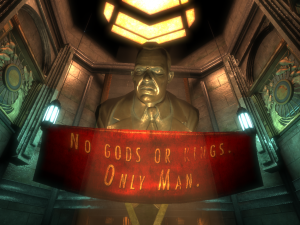Bioshock compared to another shock
Even if it didn’t have the word “shock” in its title, I think it would have been clear that Bioshock owes a lot to System Shock 2. It’s got the same sort-of-RPG thing going on, and the same FPS-in-presentation-but-not-in-emphasis vibe. It’s got the same sort of backstory revealed by audio messages and journal entries scattered in unlikely places, as well as the occasional pseudo-scientifically-justified “ghost” cutscene, a very distinctive technique. It’s got the whole business of automated gun turrets that can be hacked to be on your side, as well as the equally-hackable security cameras that summon robots (here presented as not very bright, and awkwardly flying on little helicopter blades) if you stand in front of them for more than a second or two. It even keeps some of the really idiosyncratic touches, like the way that cigarettes restore a little mana at the cost of a little health.
Where does it differ from SS2? Well, the setting, obviously. Being under the ocean isn’t very different in practical terms from being in space — in both cases, it means you’re stuck in a constrained environment in the middle of something deadly, and that the authors can make plot points of the limited oxygen supply — but at least it means that when there are windows (or, better yet, glass tunnels), there can be something interesting to see through them, like gratuitous schools of fish.
SS2, like Deus Ex, had an “Inventory Tetris” system, where picking things up required slotting them into the free space in a grid, with bulkier items taking up multiple slots. People generally didn’t like it, so Bioshock scraps it. In fact, it doesn’t have a general inventory interface at all. Some things, like the aforementioned cigarettes, are simply put outside any kind of inventory by making you use them immediately when you pick them up. Health packs and Eve hypos (mana potions) show up as a number next to the appropriate bar in the main UI, and ammo levels can be seen from a special weapon/plasmid selection screen. There doesn’t seem to be any way to get a list of your currently-installed gene tonics other than going to a Gene Bank, the machine that lets you swap different tonics into the active slots. Similarly, the only way to find out how much of the various components for “inventions” you’re carrying is to take them to one of the machines that lets you assemble them. I don’t much like this. Simplifying the interface is one thing, withholding useful information is another. I swap my gene tonics around a lot, adjusting them to the situation; as a result, I don’t necessarily know at any given moment which ones I have installed, and therefore what sort of actions I should be attempting.
Which brings us to the biggest chance from SS2: the ability to swap in different upgrades. In SS2, once you bought an upgrade, it became a permanent feature of your character. Even before the game proper started, you were asked to choose to specialize in weapons, tech, or psi (magic). I get the impression that most players never did much with the game’s magic system as a result. It wasn’t a very attractive option once you knew the rules — just as in Bioshock, the only way to gain mana was with the equivalent of potions, and at the point where you were asked to choose your specialization, you had no idea how abundant they would turn out to be. But Bioshock lets you experiment with things by changing your specialization on the fly. I compared the research mechanic to the Final Fantasy V “Jobs” system before, but this respeccing reminds me of it even more. I made negative comments about killing everything with the wrench, but if that’s how you want to play the game, you can get tonics that support it. You can even be a sneak-attack wrench specialist, thanks to a gene tonic that makes your footsteps quiet and increases the wrench’s damage against unsuspecting foes.
For my part, I haven’t done a lot of sneak wrenching, but I have come to really like another stealth-gameplay tonic, one that turns you invisible when you stand still for a second or two. There’s a particularly joyous scenario this enables: you accidentally trigger an alarm, and the bumbling and buzzing security drones come after you, so you duck behind a corner and then just stand there, and watch the bots just fly past looking for you. And by far my favorite combat technique is to use a certain plasmid to hypnotize a Big Daddy into thinking I’m a Little Sister and fighting in my defense. I don’t remember doing any of this stuff in SS2, but that’s probably just because I didn’t take the right upgrade path.
 Comments(1)
Comments(1)